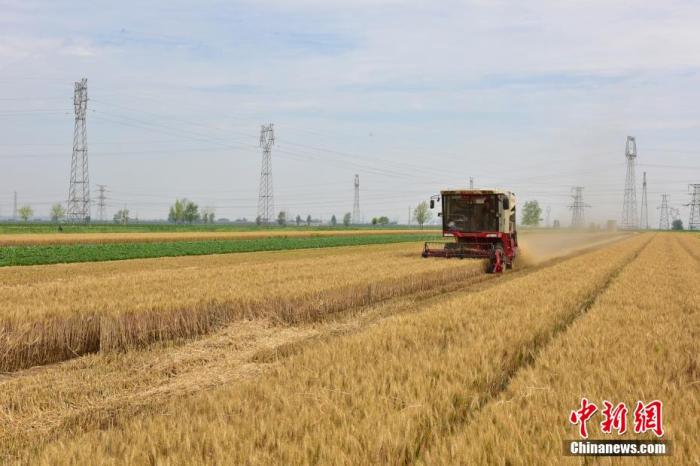China News Service, September 1st. Wei Baigang, chief economist and director of the General Office of the Ministry of Agriculture and Rural Affairs, said on the 1st that extreme weather has occurred frequently in my country this year, but the disasters are partial and phased. The country’s agricultural disasters are lighter than in previous years. , The fundamentals of this year's autumn grain harvest are still good.
Data map: Farmers drove agricultural machinery shuttled in the field to harvest.
Photo by Liu Feng
The Ministry of Agriculture and Rural Affairs held a press conference on the 1st to introduce the 2021 Chinese Farmers’ Harvest Festival and answer questions from reporters.
At the meeting, a reporter asked questions that extreme weather was frequent this year, severe flooding occurred in Henan, the second largest province in food production, and droughts also occurred in some parts of the west.
What impact does this have on autumn grain production?
Can there be a bumper harvest in the autumn crops across the country?
Wei Baigang said that extreme weather has occurred frequently in my country this year, and the disasters in some areas are indeed severe. However, my country has a vast territory and disasters occur every year and every season.
"When we study and judge the impact of disasters on the overall situation, we need to understand the scope and extent of the impact of the disaster."
Wei Baigang notified the relevant data:
First, the area of autumn grain is relatively small in the hardest-hit areas.
The area of autumn grains in Henan, which was seriously affected by the disaster, was 11 million mu, accounting for 14% of the autumn grain area in Henan Province and less than 1% of the national autumn grain area.
At present, about half of the 5.25 million mu of land in Henan has been replanted and replanted. The affected fields have basically been fertilized and sprayed. The unaffected fields have grown better than normal, which can make up for some of the losses.
Shanxi, Shaanxi, Gansu, Ningxia and other places have suffered more than 19.3 million mu due to drought, accounting for only 1.5% of the country's total, and low-yield crops such as miscellaneous grains and beans account for a relatively large proportion.
Second, the national agricultural disasters were generally lighter than in previous years.
Since June, more than 72 million mu of crops have been damaged nationwide, which is more than 39.5 million mu less than the same period last year, a decrease of nearly one-third, and there has been no harvest of 9.3 million mu and 4.3 million mu less.
The areas affected by disasters, disasters and no harvests were the lowest in the same period in the past five years.
"The prevention and control of rice pests, rice blast, Spodoptera frugiperda and other pests are now in place. From the data above, we can see that this year’s disasters are partial and staged, and the overall situation of agricultural disasters across the country is still in place. For the lighter ones, the fundamentals of this year's autumn grain harvest are still good." Wei Baigang said.
Regarding the situation of autumn grains, Wei Baigang said, first, the area has increased.
This year is the first year that the party and government are responsible for food security. All localities attach great importance to it, layer responsibilities, make great efforts to rectify "non-agriculturalization" and "non-grainization", reclaim abandoned land, and do everything possible to tap the potential of food area. The area of autumn crops has increased, especially the area of corn, a high-yield crop.
Second, the overall growth is relatively good.
At present, the growth process of autumn grain crops is normal in most areas of the country, the soil moisture is suitable, the prevention and control of diseases and insects are in place, and the crops are growing well.
Among the 13 major grain-producing provinces, with the exception of the worst-hit areas in Henan, the growth of autumn crops is relatively good, especially in the northeastern region, corn and rice have entered the milk-filling and milk-maturing to wax-maturing period, and their growth is better than the previous year and the normal year. , The trend of increasing production is obvious.
"The harvest is scheduled for August 15th, and now it is only a month away from the large-scale harvest of autumn grains. Next, we must guard against cold dew and wind in the rice-growing areas in the south, and early frosts and typhoons in the northeast and Inner Mongolia. We must not take these disasters lightly.” Wei Baigang said, “The Ministry of Agriculture and Rural Affairs has, in conjunction with relevant departments, adhered to the arrangement and deployment of regions, varieties, and links. All localities have also made preparations to prevent these disasters in advance. We are confident that we will achieve a bumper harvest for this year’s autumn crops."

